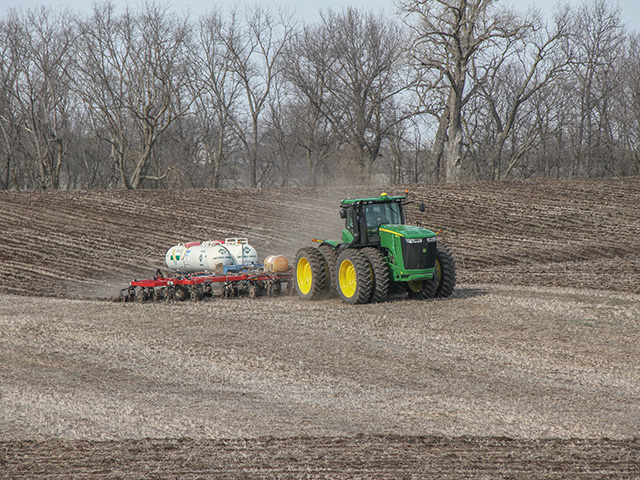Best Blog of the Week
Production Blog: Anhydrous Exposure Something to Sneeze About
DECATUR, Ill. (DTN) -- My nose is in a snit.
I saw the cloud of what appeared to be smoke ahead of me as I traveled down an Illinois state highway last week. Too late, I smelled the ammonia and spotted the tanks.
At first, I was concerned for the operator until I caught sight of the implement turning upwind to continue application. Thoughts immediately became more personal as my eyes started to water and nose hairs felt as though they were melting. I stepped on the gas to get away from the ammonia gas. Farther down the road, I was able to lower the vehicle windows to dilute the problem, but not my irritation.
Here's the deal: Temperatures that day hit north of 70 degrees Fahrenheit. OK, so we had some colder-than-normal conditions in October. Maybe soil temperatures have kept their cool, but every year there are ammonia accidents and releases reported. We have exceptionally dry conditions this fall, and the ground is hard -- making for a difficult seal and more potential losses. With agriculture always under observation, we need to be doing all we can to keep ammonia where it is intended to be -- in storage or in the ground.
Operators should always take into consideration that even if anhydrous flow is stopped some distance before the lift point, the knives will still be emitting anhydrous vapor when out of the ground. People driving past the fields (like I was that day) or living next to the fields (and likely working from home, or with kids at home these days) can be affected by any minor mistake made by the operator.
I'm admittedly not a big fan of anhydrous. I understand the need for it and the economic realities of why farmers use it. I've just had too many encounters to trust it. Unfortunately, I've also written far too many stories about debilitating injuries from working with it.
That's why it seems good news that many in the ag industry in my state of Illinois have supported new rules that will require farmers and those working for or with the farmer to have ammonia safety training before they transport, apply or work with ammonia equipment, starting next year. The training will include what to do in case of an accident, so that the operator and the public is protected from injury.
P[L1] D[0x0] M[300x250] OOP[F] ADUNIT[] T[]
Illinois Fertilizer and Chemical Association (IFCA) President Jean Payne sees support for the proposal based in reality. "A reportable release is only 18 gallons of ammonia. That's not very much," said Payne.
Here are some seasonal reminders from IFCA to keep in mind while working with ammonia:
1. Slow down! Nurse tanks should not travel down the road more than 25 mph.
2. ALWAYS turn the nurse tank valves off and disconnect hoses before pulling onto a public roadway. This is required by law. You should never have a "charged" system when sharing the road with citizens.
3. Nurse tanks should not be operated in low-light conditions or before or after sunset UNLESS you have a rotating, flashing amber light on the tank(s). Today's motorists are not as familiar or patient with farm equipment even in rural Illinois, so it is always best if slow moving vehicles are kept off the roads during non-daylight hours.
4. Never forget the safety chains, even in the field of application. Nurse tank trailers are put to the test during the ammonia season, being asked to serve as both highway vehicles and then being pulled through rough fields. The safety chains can save you from catastrophe if the hitch fails! Hook them up every time.
5. Are your quick-disconnect devices working on the toolbars? This is another safety mechanism designed to prevent releases, but they must be installed correctly and maintained so that they work. When they do work, no one hears about it. When they don't work, a call to 911 is usually the next thing that happens and then forget about getting anything else done the rest of the day (or days) ahead. Prevention is key!
6. And speaking of 911, never hesitate to make the call if you have an ammonia release. Tell the emergency operator exactly what has happened so that law enforcement and fire departments show up prepared to deal with ammonia. Whoever is in charge of the tank at the time of the release must make this call immediately! IFCA can always help you later with the paperwork, but you can't undo someone being injured from ammonia exposure.
Find more information on anhydrous safety:
-- Steps to follow in Illinois if an ammonia release occurs: https://ifca.com/…
-- Why temperature matters when applying anhydrous: https://www.dtnpf.com/…
-- Safety tips for working with anhydrous: https://www.dtnpf.com/…
-- Minnesota restrictions on fall nitrogen applications: https://www.dtnpf.com/…
Pamela Smith can be reached at pamela.smith@dtn.com
Follow her on Twitter @PamSmithDTN
(c) Copyright 2020 DTN, LLC. All rights reserved.




